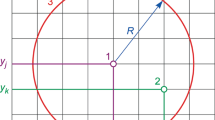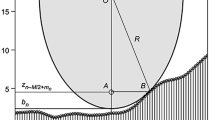Promising methods of digital morphological filtration of the texture of a surface are considered. Results of a program implementation of morphological spatial filters for three-dimensional evaluation of surface texture are presented.




Similar content being viewed by others
References
D. J. Whitehouse, Handbook of Surface and Nanometrology, CRC Press (2001).
B. Muralikrishnan and J. Raga, Computational Surface and Roundness Metrology, Springer, London (2009).
V. G. Lysenko and V. S. Luk’yanov, “Identifying irregularities in the topography of a surface by means of a spatial current averaging operator,” Izmer. Tekhn., No. 2, 13–16 (1982).
ISO 11562:1996, Geometrical Product Specification (GPS), Surface Texture: Profile Method, Metrological Characteristics of Phase Corrected Filters, International Organization for Standardization.
ISO/TS 16610–1:2015, Geometrical Product Specification (GPS) – Filtration, P. 1: Overview and Basic Concepts, International Organization for Standardization.
ISO 25178-2:2012, Geometrical Product Specification (GPS) – Surface Texture: Part 2: Terms, Definitions and Surface Texture Parameters. International Standard.
V. G. Lysenko, N. A. Tabachnikova, and D. A. Novikova, “State Primary Special Standard of the Unit of Length for the Parameters of Deviations from Planarity of Optical Surfaces with Dimension up to 200 mm,” Zakonodat. Prikl. Metrol., No. 6 (139), 10–12 (2015).
S. A. Kononogov, V. G. Lysenko, and N. A. Tabachnikova, “State Primary Special Standard of the unit of length in the area of measurements of the geometric parameters of surfaces of complex shape (GET 192–2011),” Zakonodat. Prikl. Metrol., No. 4 (119), 2–8 (2012).
S. A. Kononogov, V. G. Lysenko, and N. A. Tabachnikova, “Improvement in the State Primary Special Standard of the unit of length in the area of measurements of the parameters of surface roughness Rmax, Rz, and Ra (GET 113–2010),” Zakonodat. Prikl. Metrol., No. 4 (125), 2–11 (2013).
V. V. Poroshin, D. Yu. Bogomolov, and O. V. Poroshin, “A computer-based measurement system for three-dimensional analysis and inspection of the topography of a surface in the nanodimensional range,” STIN, No. 5, 37–40 (2015).
M. Krystek, “Morphological filters in surface texture analysis,” in: 11th Int. Colloquium on Surfaces, Chemnitz, Germany (2004), pp. 43–45.
H. von Weingraber, “Über die Eignung des Hullprofils als Bezugslinie für Messung der Rauheit,” Annals CIRP, No. 5, 116–128 (1956).
V. Radhakrishnan, “On an appropriate radius for the enveloping circle for roughness measurement in the E-system,” Annals CIRP, No. 1, 421 (1971).
M. S. Shunmugum and V. Radhakrishnan, “Two- and three-dimensional analyses of surfaces according to the E-system,” Proc. Inst. Mech. Eng., 188, No. 1, 691–699 (1974).
G. Matheron, Random Sets and Integral Geometry, Wiley, New York (1975).
J. Serra, Image Analysis and Mathematical Morphology, Academic Press, New York (1982).
V. Srinasan, “Discrete morphological filters for morphology,” in: Proc. 6th ISMQC Symposium on Metrology for Quality Control in Production, TU Wien, Austria (1998).
E. Decenciere and D. Jeulin, “Morphological decomposition of the surface topography of an internal combustion engine cylinder to characterize wear,” Wear, 249, 482–488 (2001).
J. Kumar and M. S. Shunmugam, “Morphological operations on engineering surfaces using a 3D-structuring element of an appropriate size,” Measur. Sci. and Technol., 17, No. 10, 2655–2664 (2006).
M. Yazdchi, A. Mahyari, and A. Nazeri, “Detection and classification of surface defects of cold rolling mill steel using morphology and neural network,” in: Int. Cost Computational Intelligence for Modeling Control & Automation (2008), pp. 1071–1076.
D. Lee, Y. Kang, C. Park, and S. Won, “Defect detection algorithm in steel billets using morphological Top-hat filter,” IFAC Workshop on Automation in Mining, Mineral and Metal Industry (IFACMMM) (2009).
P. J. Scott, “Scale-space techniques,” Proc. 10th Int. Colloquium on Surfaces (2000), pp. 153–161.
S. Lou, X. Jiang, and P. J. Scott, “Correlating motif analysis and morphological filters for surface texture analysis,” Measurement, 46, No. 2, 993–1001 (2013).
S. Lou, X. Jiang, and P. J. Scott, “Application of the morphological alpha shape method to the extraction of topographic features from engineering surfaces,” Measurement, 46, No. 2, 1002–1008 (2013).
Author information
Authors and Affiliations
Corresponding author
Additional information
Translated from Metrologiya, No. 2, pp. 3–14, April–June, 2016.
Rights and permissions
About this article
Cite this article
Poroshin, V.V., Bogomolov, D.Y., Poroshin, O.V. et al. Use of Morphological Spatial Filtration of Surface Irregularities for Three-Dimensional Parametric Evaluation of Texture. Meas Tech 59, 637–643 (2016). https://doi.org/10.1007/s11018-016-1023-0
Received:
Published:
Issue Date:
DOI: https://doi.org/10.1007/s11018-016-1023-0




